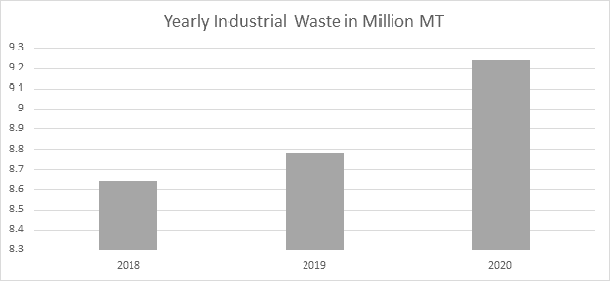Development in various sector across the world are causing pollution and degrading the planet earth. Of the various pollution caused soil pollution is of significance as it is hampering the soil fertility which is necessary to support diverse vegetation. In maintenance of healthy ecosystems there is interaction of biotic and abiotic elements. Soil is one of the vital abiotic factor that is necessary for plant life and luxuriant forests which are home to diverse faunal species. Hazardous chemicals and constituents from various industrial sectors result in soils that have presence of heavy metals and hazardous constituents. The plants absorb nourishment through roots from these polluted soils. This results in bio magnification of hazardous constituents in the herbivores that feed on such plants and the carnivores those feed on the herbivores.

Industrial Waste Generation in India Statistics

Of all the various sectors, healthcare sector is significantly contributing to the biomedical waste that is generating hazardous waste. The total waste generated is around 1.15 lakh tonnes which consists of nearly 600 tonnes of biomedical waste. The sites for generation of biomedical waste are hospitals, research institutions, health care teaching institutes, clinics, laboratories and blood banks. The waste is generated as a result of various procedures for diagnosis, treatment, pathological tests, surgeries and research. The best way for BMW management is avoiding generation of waste or managing as much as waste as possible at the site of generation, rather than disposing. The most common method to decompose the waste in dumping at the sites which are away from residential areas. The hospital waste ;/before dumping is sterilized. The soil in these landfills is degraded which is the site for hazardous biological pathogens and chemical constituents. Ecosystems thrive in such locations and can be sources of pollution in other locations due to mobile sources.

Disposal of Biomedical Waste from Hospitals & Laboratories

Biomedical Waste in India Statistics

Soil is a natural resource which is produced due to weathering of rocks after years of degradation. The upper layer of the soil which is the superfine weathered rock with organic degraded elements support vegetation that is diverse and rich. Damage to such soils due to dumping of biomedical waste degrades its nutritive values and within less duration pollutes the soil that is formed over centuries. In order to save the resources, it is necessary to invest in the solutions that would save depletion of our treasured resources that have formed over several centuries.
The best way to mitigate the menace of soil pollution is by decreasing the production at the site of origin. For this the rational use of resources is suggested at the hospitals, laboratories and research institutes. Secondly it is important to segregate the waste and discard in a way that can be less harmful to the environment. The products that are harmful can be marked at the manufacturing sites for its harmful nature and can be prudently used to avoid the generation of hazardous waste. Investing in solutions that can decrease the waste disposed can lessen the burden on the environment. Such practices can be incorporated in the standard operating procedures of the organizations for effective implementation.
Let us all contribute immensely to save the treasure that has been created over centuries to foster ecosystems and lives.


























